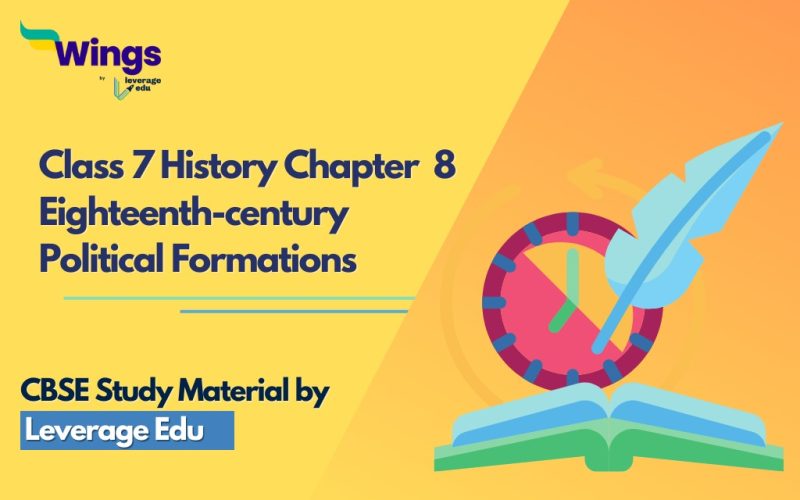NCERT Class 7 History Chapter 8 is about the political environment of 18th-century India, which was ruled by the Mughal Empire. Also, the lesson introduces the Rajput provinces and Sikh warriors in the 18th-century undivided India. Explore a summary of the kings and kingdoms in the subsequent section of the blog. Thereafter, you can access important events under different political regimes in different parts of India. Lastly, you can download NCERT solutions to important questions in Class 7 History Chapter ‘Eighteenth-Century Political Formations’.
Download Social Science Class 7 History Chapter 8 Important Questions and Answers PDF
Table of Contents
Also Read: Maratha Empire (1674-1818): History, Wars, and Important Leaders
Explore Notes of Class 7 History Chapters Here
Summary: NCERT Class 7 History Chapter 8
NCERT Class 7 History Chapter 8, ‘Eighteenth-Century Political Formations” highlights the significant events of the eighteenth century, focusing on political formations. It begins with the decline of the Mughal Empire, marking the era of the Later Mughals and the challenges they faced. The emergence of new states takes centre stage, showing how various regions began to assert their independence. The chapter sheds light on the Old Mughal Provinces, revealing how they evolved in this changing political landscape. The Watan Jagirs of the Rajputs are discussed, highlighting their unique socio-political setup. Also, the chapter explores the struggle for independence by the Sikhs, Jats, and Marathas.
Eighteenth Century Political Formations Class 7 Lesson Plan
The lesson plan of the NCERT Class 7 History Chapter 8 Eighteenth-Century Political Formations is as follow:
- The Crisis of the Empire and the Later Mughals
- The Rajputs
- Seizing Independence
Check out the latest updates on board examinations of various states
| Board Exam Date 2024 | CBSE Date Sheet 2024 |
| Maharashtra Board Time Table 2024 | Tamil Nadu Board Exam Date Sheet 2024 |
| UP Board Exam Dates 2024 | MP Board Exam Dates 2024 |
Download Social Science Class 7 History Chapter 8 Important Questions and Answers PDF
Download NCERT Solutions of Class 7 History Chapters Here
Important Questions and Answers in NCERT Class 7 History Chapter 8
1. State whether true or false:
(a) Nadir Shah invaded Bengal. False
(b) Sawai Raja Jai Singh was the ruler of Indore. False
(c) Guru Gobind Singh was the tenth Guru of the Sikhs. True
(d) Poona became the capital of the Marathas in the eighteenth century. True
2. How were the Sikhs organized in the eighteenth century?
Ans. Under a number of able leaders in the eighteenth century, the Sikhs organized themselves into a number of bands called jathas, and later on misls. Their combined forces were known as the grand army (dal khalsa). The entire body used to meet at Amritsar at the time of Baisakhi and Diwali to take collective decisions known as “resolutions of the Guru (gurmatas)”. A system called rakhi was introduced, offering protection to cultivators on the payment of a tax of 20 percent of the produce.
3. Why did the Marathas want to expand beyond the Deccan?
Ans. The Marathas wanted to expand beyond the Deccan to decrease the Mughal influence. Under the Peshwas, the Marathas developed a very successful military organization. Their success lay in bypassing the fortified areas of the Mughals, by raiding cities and engaging Mughal armies in areas where their supply lines and reinforcements could be easily disturbed. Between 1720 and 1761, the Maratha empire expanded. It gradually chipped away at the authority of the Mughal Empire. Malwa and Gujarat were seized from the Mughals by the 1720s. By the 1730s, the Maratha king was recognized as the overlord of the entire Deccan peninsula.
Check out Class 6 History Notes:
FAQs
Ans: Guru Gobind Singh Ji was the tenth Guru of the Sikhs.
Ans: Poona became the capital of the Marathas in the eighteenth century.
Ans: The Marathas wanted to expand beyond the Deccan to decrease the Mughal influence.
Follow Leverage Edu for complete study material on CBSE Notes of Class 7 History
 One app for all your study abroad needs
One app for all your study abroad needs













